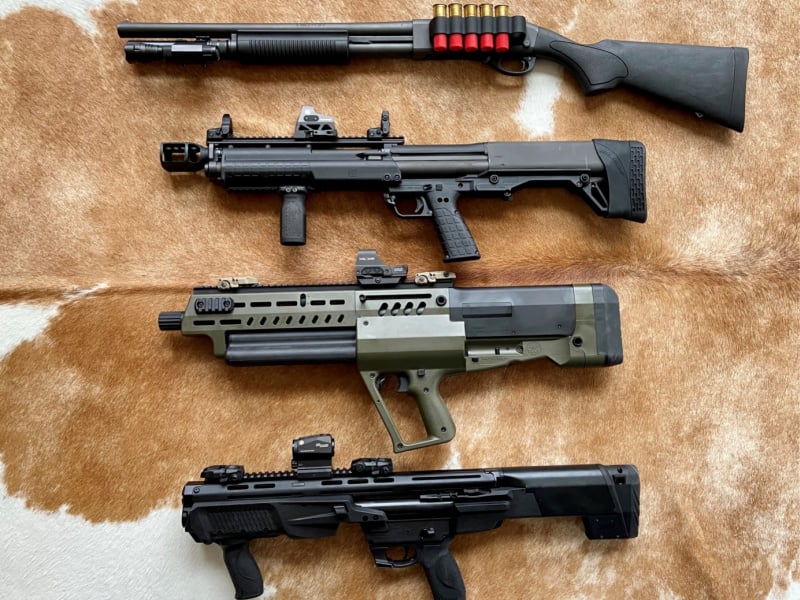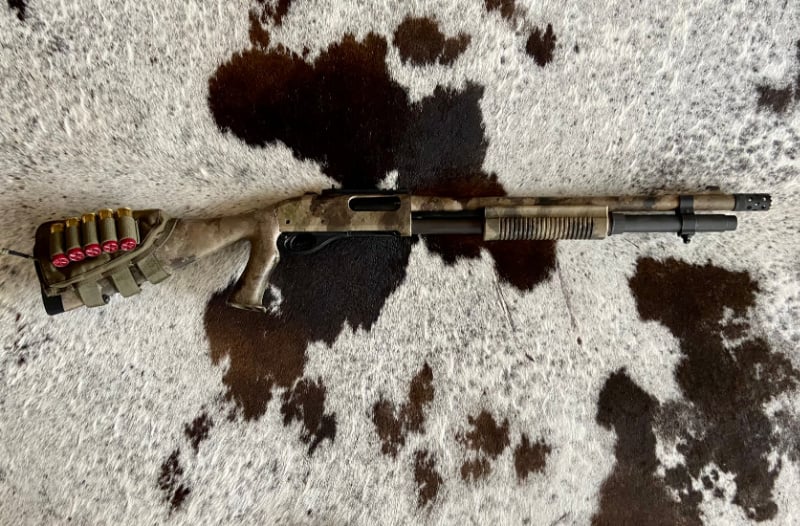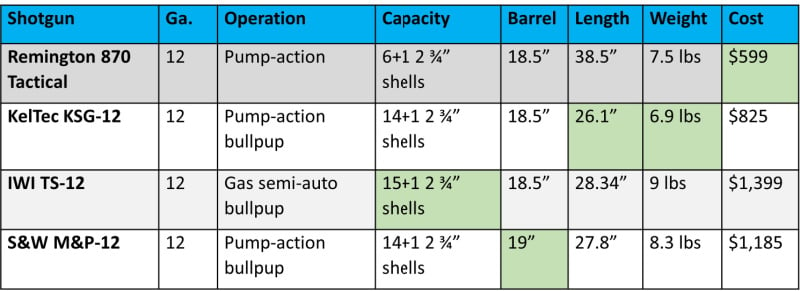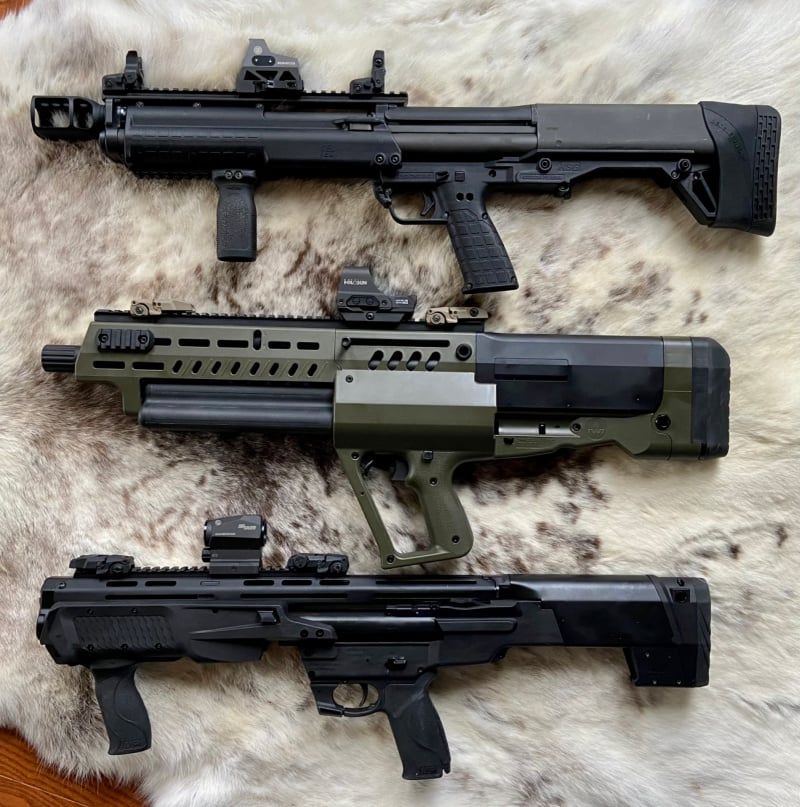One of the areas of innovation over the past few decades has been higher capacity 12-gauge shotguns designed more for home defense than hunting or sporting uses. In my opinion, the Remington 870 pump-action is a great all-around shotgun, but as a friend of mine often says, “I don’t want to ever die due to a lack of shooting back.” This would be the ‘more is always better’ philosophy of available ammo/shells.

I do believe other factors such as weight, action (pump versus semi-auto), ease of use/access, length, and even cost should be accounted for in the choice of a defensive weapon. However, it is also hard to argue with having more shells, allowing you to cover more potential situations (no matter how unlikely). Additionally, though semi-automatic shotguns can be highly reliable with the right ammo, I generally prefer the overall efficiency and ‘will chew through any ammo’ of pump action shotguns. Semi-automatic shotguns tend to run better with higher velocity shells as the cycling of rounds is dependent on the energy within the shell.
Shotgun Magazine Extensions
Personally, I am a sucker for innovative larger-capacity home defense shotguns. Higher capacity (7+ shells) shotguns come in three broad varieties. The first is a traditional longer shotgun with a tube magazine extension (often adding two or three shells to capacity). All my Remington 870s — strategically placed and securely stored around our property — are equipped with these extensions. Assuming the gun does not have a built-in stop limiting how many shells can be loaded, these magazine extensions are generally affordable and easy to install and add a few more shells to an already reliable system. The downside is these tube extensions only add a few shells and traditional longer shotguns are not the greatest option compared to a more compact weapon that allows better maneuverability in tight home defense situations.

Detachable Shotgun Magazines
The second way to increase capacity is through the addition of a detachable box magazine. Several companies have come out with variations on this theme in both pump action (Mossberg 590) and semi-automatic versions (Rock Island’s VR80 built around the AR platform). Factory magazines often hold five to ten shells. By adding additional magazines beyond what the factory provides, the overall capacity can be as high as 20 shells. The price point on these additional magazines generally ranges from $35 to $100. The advantage of extra magazines with very high capacity is the overall shell count and the ability to quickly reload. The downsides include magazine weight, and at least for the semi-automatics, some fickleness in what shells the gun will reliably run.
Multiple Magazine Tube Bullpups
Although I have shotguns from the first two categories, the third method of increased capacity appeals to me as the most innovative solution. These are shotguns utilizing multiple tubes for capacity while offering an overall shorter system than most of the other methods. The shorter overall length comes with a bullpup design with the breech of the shotgun behind the primary grip and trigger. Outside of an apocalyptic scenario, these guns, if ever used, would be most likely home defense guns so I also like the reduced length. With reduced overall length comes greater maneuverability if needing to move through tightly confined interior spaces. See Figure 1 for a comparison between these models and a Remington 870 Tactical for comparison.

KSG-12
The first widely seen version of these shotguns was KelTec’s KSG-12 released in 2011 and featured prominently in the movie “John Wick” in 2014. The KelTec KSG-12 is a pump action bullpup design featuring a rear selector allowing the shooter to switch between two seven-shell tubes. Although first on the market, it still wins as the shortest and lightest of the three commonly available multi-tube magazine shotguns. It is also the cheapest.
I have had great luck with mine, running hundreds of shells through it over the years, and with vigorous use of the pump-action I have never experienced any feeding issues. Admittedly, with the lighter weight and cost, there is a certain level of long-term durability that may be called into question by some. For instance, I am not sure I would trust this shotgun in a multiple-day shotgun class that might be rough on the guns.

The tube magazine selector (alternating between the two tubes) is set within the magazine loading port behind the grip and trigger. This allows for alternating what shell is chambered from which tube, or simply can be switched once a tube is empty. The safety is above the pistol grip and can be conveniently operated by the right trigger finger (to set it to safe) or the thumb (to set it to fire). The action release is located directly forward of the trigger and can easily be operated by the trigger finger. I have mine set up with co-witnessed Magpul flip-up AR iron sights, a Sig Sauer Romeo red dot optic, Magpul vertical front grip, a Pachmayr Decelerator recoil pad, and a Hi-Tech Howitzer70 muzzle break. Though the stock version of this gun is the shortest of the options reviewed, my personal one is longer due to the recoil pad and muzzle break. There is no question this gun gets a lot of looks when it is out on the range.
TS-12
Israel Weapon Industries (IWI) released their TS-12 in 2018 utilizing a gas-operated semi-automatic bullpup design but featuring three rotating five-round tubes to the front of the shotgun. The semi-automatic nature of this gun is great for recoil reduction, but like most semi-automatic shotguns it is particular with what shells it likes to run. I have only run higher velocity 00 buck through this gun but have had no issues.
When a tube is empty, rotating to the next tube is a manual process but chambers the next round as it is completed. The controls can easily be converted for left-hand dominant shooters. The bolt is accessed at the top of the shotgun, with a safety positioned above the trigger grip (operated by either the trigger finger or dominant thumb). The release for the three magazine tubes is directly forward of the trigger. I have mine set up with Magpul co-witnessed flip-up AR iron sights and a larger windowed Holosun HE510-C green dot optic.
M&P-12
Smith and Wesson (S&W) joined the market in 2021 with the M&P-12, also featuring two magazine tubes with a selector and a pump action bullpup design. Though similar to the KelTec, including loading and front of the trigger action release, there are some differences including an ambidextrous AR-style safety selector above the trigger grip and included vertical front grip. The largest functional difference is that the tube selector is incorporated into the forestock, allowing easy switching from magazine tube to magazine tube with your non-dominant hand. Rounding out my setup on this shotgun is (seeing a trend here) a set of Magpul flip-up AR iron sights and Sig Sauer Romeo 5XDR red dot optic. Like the KelTek, I have run a variety of shells through this gun with no issues.

All three guns can take up to 3” shells (at a reduced total capacity) and provide many of the same pros and cons. Pros include being overall shorter than comparable shotguns, high-capacity magazines (though all three require some practice to quickly, easily, and effectively switch between tubes), and the mass and operation of the shotgun are closer in allowing for better control.
Cons include a less-than-perfect trigger experience common with bullpups, and some difficulty quickly reloading compared to a standard shotgun when you shoot the gun dry. Though I like all three for overall feel and function I prefer the IWI TS-12 but recognize that the reduced recoil and coolness factor of semi-automatic fire comes with some ammunition sensitivity.
Have any of these replaced my home defense guns? Currently no, but I also have decades and thousands of shells through my Remington 870s. For now, I’ll leave my experimentation to the range, but I will let you know if I change my mind.


